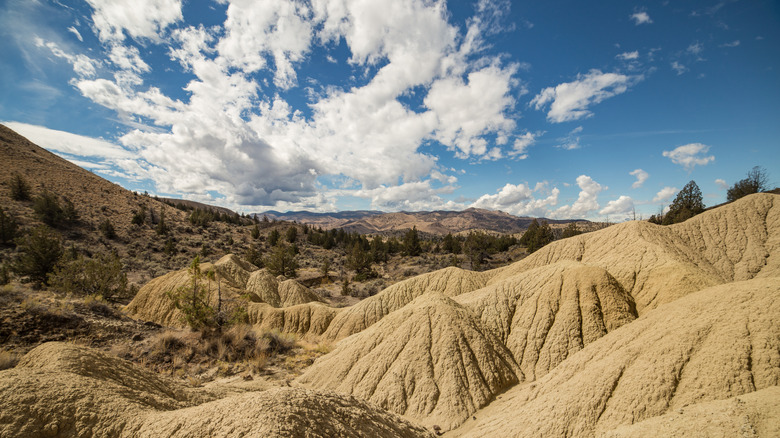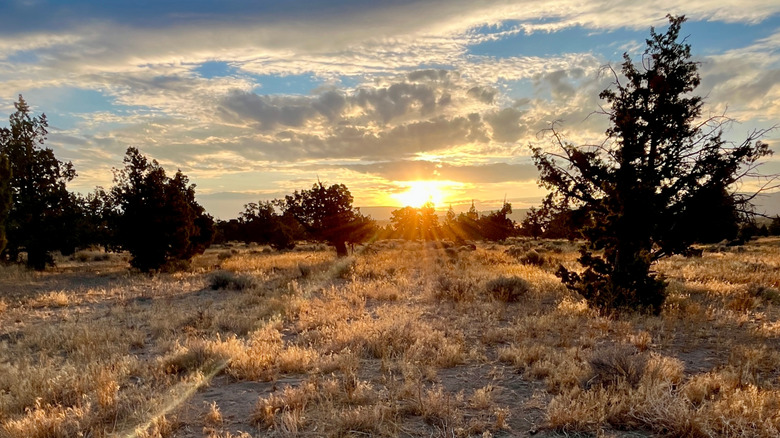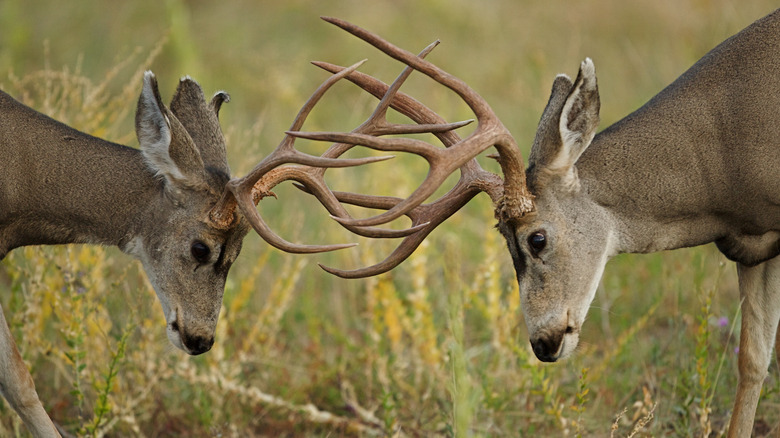Oregon's Most Unexpected Landscape Is This Unique 'Badlands' Wilderness Outside Of Trendy Bend
While many people associate Oregon with cool, lush forests and a misty, windswept coastline that is home to gems such as this secret beach, that doesn't tell the whole story. Central Oregon — which lies on the eastern side of the Cascade Range — is anything but rain-soaked. This is a wide-open land of sunny skies and majestic, high desert scenery that plays against the images of swirling clouds, moss, and constant drizzle that so many people associate with the Pacific Northwest.
Situated just about 15 miles east of the charming, outdoorsy town of Bend, Oregon — an ideal destination for fun fall adventures — is the Oregon Badlands Wilderness. This 29,180-acre spread of low-rising hills, basalt rock, juniper, sagebrush, canyons, and grasslands is a classic Central Oregon location that's worth exploring. Often overlooked for more well-known attractions in the area, the Oregon Badlands Wilderness is an ideal spot for hiking, camping, wildlife viewing, and — once the sun goes down — some of the best stargazing the Beaver State has to offer.
Explore a fascinating volanic landscape
The Oregon Badlands were formed 80,000 years ago with the eruption of the Newberry Volcano, whose lava flow helped to mold this extraordinary landscape. The subsequent eruption of nearby Mount Mazama — which formed the deepest lake in America — blanketed the region in ash and sand that eventually turned into rock. Thousands of years of erosion sculpted this volcanic stone into the ravines, pressure ridges known as tumuli, and castle-like formations that make up the remarkable spread of land we see today.
Managed by the Bureau of Land Management, many come to the reserve to camp. This is free, dispersed camping with absolutely no amenities, so arrive well-prepared – including bringing plenty of water. However, despite the lack of luxuries, the Oregon Badlands more than make up for it in high desert scenery, and come nighttime, in stargazing, when the dark skies turn into a glimmering tapestry of heavenly bodies. One popular spot to take in the planets and Milky Way is Reynolds Pond, whose glassy, placid waters reflect the light show above, making for an impressive sight.
The Oregon Badlands Wilderness also boasts nearly 50 miles of trails, popular with hikers, trail runners, and equestrians. These include routes such the Flatiron Rock Trail, which heads to the top of the formation it's named for, where you can enjoy sweeping views of the open landscape with the Cascades in the distance. There's also the Tumulus, Basalt, and Black Lava Loop Trail — a 6.7-mile jaunt featuring volcanic geological forms such as lava flows and cinder cones — while the Ancient Juniper Trail winds through stands of these iconic trees and is a great place to take in wildflowers in the spring.
A high desert habitat teeming with wildlife
Despite the arid conditions, Oregon's Badlands are home to a host of creatures, including mule deer, elk, antelope, coyotes, bobcats, mountain cottontails, and yellow-bellied marmots. In addition, the reserve is a terrific area for birding — especially when it comes to raptors such as golden eagles, falcons, hawks, and great horned owls. Like most of Central Oregon, it's also rattlesnake country, so watch where you step. If you do come across any tail-shaking serpents, slowly back away and make sure to keep your distance.
In addition to the abundant wildlife and natural wonder, the Oregon Badlands Wilderness also contains human heritage. There are Native American petroglyphs in the area, most notably off the Dry River Cave Trail. Just make sure to treat any historical relics with respect: Not only is it good manners, it's also the law.
The Oregon Badlands are best explored October through May, when the temperatures are most bearable. Just bundle up in the winter, as it's often cold, especially at night. On the other hand, temperatures are positively sizzling come summer, and the trails and surroundings can get dusty, so set off early on any hikes and make sure to bring more than enough water. For more of Central Oregon's natural treasures, check out this breathtaking, crystalline lake.


